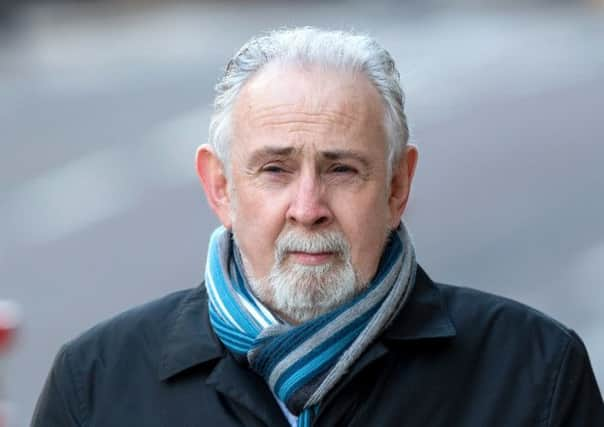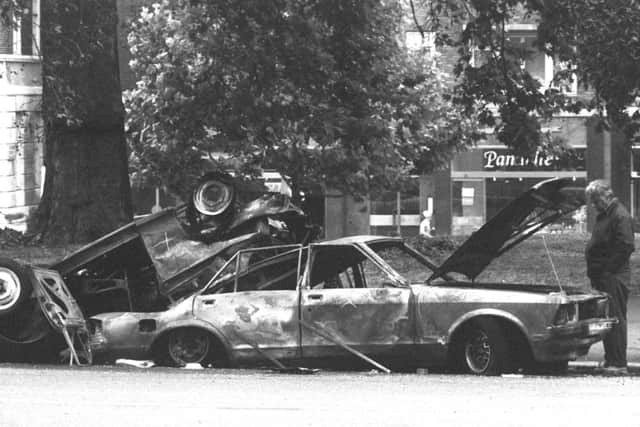Hyde Park: Blunder lets IRA bomb suspect go free


A judge threw out the case against John Downey, a convicted member of the IRA who was the prime suspect for the London bombing, after it emerged that he had received a “letter of assurance” from the police in Northern Ireland in 2007 that he would not face criminal charges, despite the fact there was an outstanding warrant for his arrest.
Although the police in Northern Ireland later realised their mistake, the assurance was never withdrawn – an error the judge said amounted to a “catastrophic failure” that misled the defendant.
Advertisement
Hide AdAdvertisement
Hide AdLast night, families of the victims of the attack said they felt “devastatingly let down” after the prosecution announced it would not appeal against the decision to throw out the case.


Downey, 62, of County Donegal, was arrested and charged last May at Gatwick airport en route to Greece. He denied the murder of four soldiers and conspiring to cause an explosion.
The judge, Mr Justice Sweeney, threw the case out after Downey’s lawyer successfully argued at the 11th hour that the defendant should not go on trial at the Old Bailey.
Yesterday, the Crown announced that it would not appeal against the decision, allowing details of the case to be published for the first time.
Last night, Police Service of Northern Ireland (PSNI) chief constable Matt Baggott apologised to the families of the Hyde Park victims for the error by his force. He said the PSNI accepted the court’s decision and full responsibilty for the failures which resulted in Downey walking free.
“I deeply regret these failings, which should not have happened,” he said.
He added that the matter will now be referred to the Police Ombudsman for Northern Ireland and that checks were under way on information dealt with by the force in other similar cases.
In a statement, relatives of the four soldiers said: “It is with great sadness and bitter disappointment that we have received the full and detailed judgment and that a trial will now not take place.
Advertisement
Hide AdAdvertisement
Hide Ad“This news has left us all feeling devastatingly let down, even more so when the monumental blunder behind this judgment lies at the feet of the Police Service of Northern Ireland.”
At an earlier hearing, Henry Blaxland QC warned of the political ramifications in Northern Ireland of pursuing a trial against Downey in such circumstances, saying the false assurance he received was “not just negligent, it was downright reckless”.
In his judgment, Mr Justice Sweeney said there were “very particular circumstances” of the case. The public interest in prosecution was “very significantly outweighed” by the public interest in ensuring that “executive misconduct does not disrepute”, and in “holding officials of the state to promises they have made in the full understanding of what is involved in the bargain”.
Last night, Northern Ireland Secretary Theresa Villiers said police in Northern Ireland should reflect on “the serious error”.
The president of the Association of Chief Police Officers, Sir Hugh Orde, who was chief constable of Northern Ireland at the time of the error, said: “It is a matter of great personal regret that a crucial oversight was made by a senior officer which resulted in erroneous information being sent to Mr Downey by the Northern Ireland Office and thus prejudicing the current indictment.”
Announcing the Crown would not appeal, prosecutor Brian Altman QC acknowledged the pain of the victims’ families “who must live with the consequences of it daily, and with the memories of that dreadful event”.
On 20 July 1982, a car bomb left in South Carriage Drive in central London killed the soldiers as they rode through Hyde Park to the changing of the guard. The explosion killed Roy Bright, Dennis Daly, Simon Tipper and Jeffrey Young, and injured other members of the Royal Household Cavalry. Seven horses were also killed as the soldiers travelled from their barracks to Buckingham Palace. Another horse, Sefton, survived terrible injuries and became a national hero.
The investigation into the bombing led police to Downey through fingerprints on parking tickets and a description given by witnesses of two men carrying out a reconnaissance in the area before the attack.
Advertisement
Hide AdAdvertisement
Hide AdAn arrest warrant was issued, but it was decided not to seek Downey’s extradition from the Irish Republic in 1989, in part due to the lack of strong evidence against him, the court was told.
Then, in 2007, Downey received assurance he was not at risk of prosecution as part of a scheme run by the Northern Ireland police.
He was one of 187 people wanted for terror-related offences during the Northern Ireland Troubles – known as “on the runs” (OTRs) – who sought assurances from the authorities in the wake of the Good Friday Agreement.
Mr Blaxland said: “Sinn Fein impresses it is impossible to overstate the importance of the assurances given to the 187
people.”
Warning of the political fallout if a trial should go ahead, Mr Blaxland said: “Once the trust starts to break down, the whole edifice starts to crumble.”
The court heard that Downey had been heavily involved in the peace process long before the Good Friday Agreement and had given up his oyster farm to work on it full-time.
The court was told by Downey’s legal team that there were other factors, aside from the clerical error, that meant he should not face trial.
These included the length of time – more than 30 years – since the offence, as well as a commitment in 2001 not to pursue those who might benefit from early release schemes.
Advertisement
Hide AdAdvertisement
Hide AdIn his judgment, Mr Justice Sweeney only upheld the argument that the letter of assurance and the failure to correct it amounted to an abuse of process.
A statement from the Metropolitan Police said the force “respects the decision of the court” and the investigation “remains open”.
Speaking outside the High Court where yesterday’s hearing took place, Sinn Fein’s Francie Molloy welcomed the judge’s decision.
Asked what the case might mean for other OTRs, the Mid Ulster MP said: “We are dealing with the John Downey case today. I welcome the decision and he is free to go home today.”
Downey, who was in court for the hearing, declined to comment.
Background
Moral maze overshadows Northern Ireland’s move forward
The collapse of the case against John Downey over the 1982 Hyde Park bombing after he was falsely told that he was not wanted by British police has highlighted difficulties in addressing the legacy from Northern Ireland’s conflict.
It shines a light on one of the most contentious unresolved issues of the 30-year Troubles – what to do about terrorist suspects who are on the run from justice.
To families whose loved ones were murdered or maimed, allowing fugitives to return home without serving a single day in prison looks like an amnesty from justice. To others, including Sinn Fein, the toxic influence of history needs to be dealt with through a South African-style truth-telling and reconciliation commission whereby those who took part, in their view war combatants, can speak free from fear of prosecution.
Advertisement
Hide AdAdvertisement
Hide AdNorthern Ireland’s attorney general, John Larkin QC, crystallised the debate but also prompted a furious political reaction with his intervention last year. “More than 15 years have passed since the Belfast Agreement, there have been very few prosecutions, and every competent criminal lawyer will tell you the prospects of conviction diminish, perhaps exponentially, with each passing year, so we are in a position now where I think we have to take stock,” he said. “It strikes me that the time has come to think about drawing a line, set at Good Friday 1998, with respect to prosecutions, inquests and other inquiries.”
Prime Minister David Cameron said the government had no plans to legislate on any form of amnesty and Irish Premier Enda Kenny warned it could breach international human rights norms.
But the issue of the past is arguably still the most emotive facing post-conflict Northern Ireland. With more than 3,000 killed during the Troubles and most murders unsolved, countless bereaved continue to campaign for truth and justice.
An agreed mechanism to address the conflict legacy has proved elusive.
The most recent attempt, by former US diplomat Richard Haass, who failed to broker an all-party agreement in December, proposed limited immunity from prosecution for those who testified about their chequered past.
His mooted Commission For Information Retrieval would allow all forces responsible for conflict deaths, from the IRA to the British Army, to give evidence in a truth commission-style forum.
Evidence
Details that saw Downey heading for murder trial
Evidence from the Hyde Park bombing of 20 July 1982 quickly led police to convicted IRA member John Downey.
But the opportunity to let a jury decide on whether he was guilty or innocent of the IRA attack has eluded authorities and families of the victims. At the time, evidence was not considered by the attorney general or police to be strong enough to secure a successful extradition from the Irish Republic.
Advertisement
Hide AdAdvertisement
Hide AdNevertheless, a warrant for Downey was issued by Scotland Yard and remained active for three decades in case he should come into the UK of his own accord. The evidence centred on NCP parking tickets with Downey’s fingerprints on them.
The bombing was caused by a remote improvised explosive device containing 20-25 pounds of commercial high explosive and wire nails. It was hidden in the boot of a car parked in South Carriage Drive and detonated as the guard was passing by.
The car, a Marina, was bought the week before at a car auction in Enfield by a man with an Irish accent who gave false details, according to the court document.
The prosecution case was based on the fact Downey had been convicted in 1974 of being a member of the IRA. His appearance in 1982 was allegedly consistent with photofits and artist’s impressions created from three witnesses who reported two men carrying out reconnaissance in South Carriage Drive on 30 June and 1 July 1982.
Furthermore, three of Downey’s fingerprints were found on a ticket dispensed when the Marina was driven into an NCP car park in Portman Square, London, on 17 July 1982 and surrendered when it was driven away the following day – two days before the bombing.
Two more fingerprints were found on the ticket dispensed when the Marina was driven into an NCP car park at the Royal Garden Hotel in Kensington, west London, at 6:39pm on Sunday July 18 1982 and driven away at 6:51am on Tuesday 20 July, just four hours before the bombing, the judgment said.
Downey became a suspect when police allegedly matched his fingerprints on the Royal Garden Hotel ticket with prints taken by the Garda in the Irish Republic in July 1980. A photograph of Downey was believed to match a photofit from one of the witnesses, the judgment said.
After he was arrested last year at Gatwick airport, Downey was charged with the four murders and with causing an explosion.
Members of the victims’ families sat in the public gallery as lawyers for the prosecution and defence argued over whether a trial should go ahead.